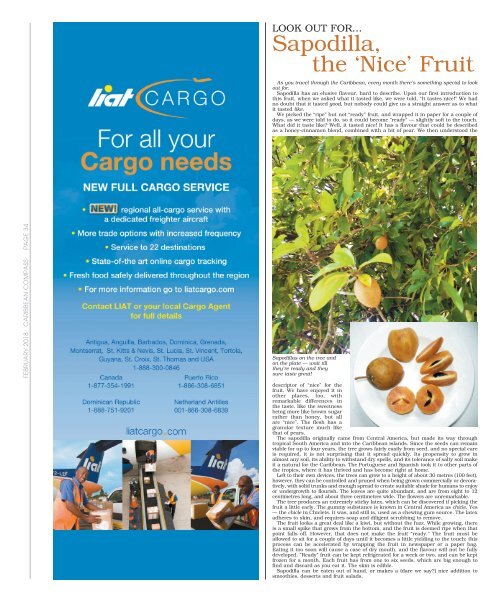Caribbean Compass Yachting Magazine - February 2018
Welcome to Caribbean Compass, the most widely-read boating publication in the Caribbean! THE MOST NEWS YOU CAN USE - feature articles on cruising destinations, regattas, environment, events...
Welcome to Caribbean Compass, the most widely-read boating publication in the Caribbean! THE MOST NEWS YOU CAN USE - feature articles on cruising destinations, regattas, environment, events...
You also want an ePaper? Increase the reach of your titles
YUMPU automatically turns print PDFs into web optimized ePapers that Google loves.
LOOK OUT FOR…<br />
Sapodilla,<br />
the ‘Nice’ Fruit<br />
As you travel through the <strong>Caribbean</strong>, every month there’s something special to look<br />
out for.<br />
Sapodilla has an elusive flavour, hard to describe. Upon our first introduction to<br />
this fruit, when we asked what it tasted like, we were told, “It tastes nice!” We had<br />
no doubt that it tasted good, but nobody could give us a straight answer as to what<br />
it tasted like.<br />
We picked the “ripe” but not “ready” fruit, and wrapped it in paper for a couple of<br />
days, as we were told to do, so it could become “ready” — slightly soft to the touch.<br />
What did it taste like? Well, it tasted nice! It has a flavour that could be described<br />
as a honey-cinnamon blend, combined with a bit of pear. We then understood the<br />
FEBRUARY <strong>2018</strong> CARIBBEAN COMPASS PAGE 34<br />
Sapodillas on the tree and<br />
on the plate — wait till<br />
they’re ready and they<br />
sure taste great!<br />
descriptor of “nice” for the<br />
fruit. We have enjoyed it in<br />
other places, too, with<br />
remarkable differences in<br />
the taste, like the sweetness<br />
being more like brown sugar<br />
rather than honey, but all<br />
are “nice”. The flesh has a<br />
granular texture much like<br />
that of pears.<br />
The sapodilla originally came from Central America, but made its way through<br />
tropical South America and into the <strong>Caribbean</strong> islands. Since the seeds can remain<br />
viable for up to four years, the tree grows fairly easily from seed, and no special care<br />
is required, it is not surprising that it spread quickly. Its propensity to grow in<br />
almost any soil, its ability to withstand dry spells, and its tolerance of salty soil make<br />
it a natural for the <strong>Caribbean</strong>. The Portuguese and Spanish took it to other parts of<br />
the tropics, where it has thrived and has become right at home.<br />
Left to their own devices, the trees can grow to a height of about 30 metres (100 feet),<br />
however, they can be controlled and pruned when being grown commercially or decoratively,<br />
with solid trunks and enough spread to create suitable shade for humans to enjoy<br />
or undergrowth to flourish. The leaves are quite abundant, and are from eight to 12<br />
centimetres long, and about three centimetres wide. The flowers are unremarkable.<br />
The tree produces an extremely sticky latex, which can be discovered if picking the<br />
fruit a little early. The gummy substance is known in Central America as chicle. Yes<br />
— the chicle in Chiclets. It was, and still is, used as a chewing gum source. The latex<br />
adheres to skin, and requires soap and diligent scrubbing to remove.<br />
The fruit looks a great deal like a kiwi, but without the fuzz. While growing, there<br />
is a small spike that grows from the bottom, and the fruit is deemed ripe when that<br />
point falls off. However, that does not make the fruit “ready.” The fruit must be<br />
allowed to sit for a couple of days until it becomes a little yielding to the touch; this<br />
process can be accelerated by wrapping the fruit in newspaper or a paper bag.<br />
Eating it too soon will cause a case of dry mouth, and the flavour will not be fully<br />
developed. “Ready” fruit can be kept refrigerated for a week or two, and can be kept<br />
frozen for a month. Each fruit has from one to six seeds, which are big enough to<br />
find and discard as you eat it. The skin is edible.<br />
Sapodilla can be eaten out of hand, or makes a (dare we say?) nice addition to<br />
smoothies, desserts and fruit salads.


















